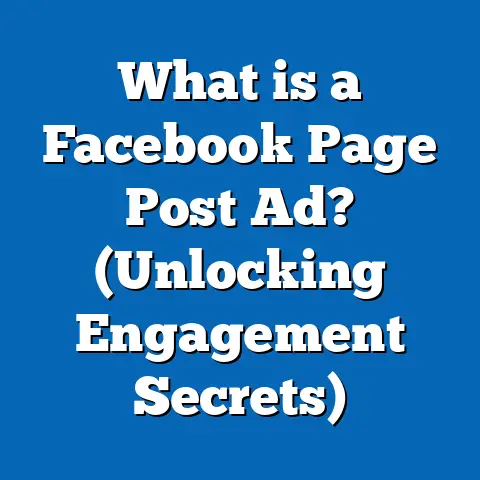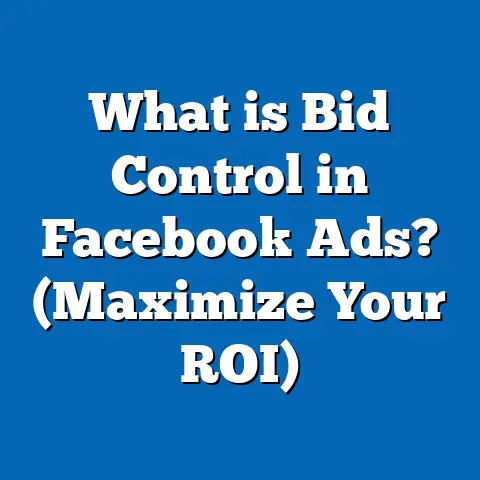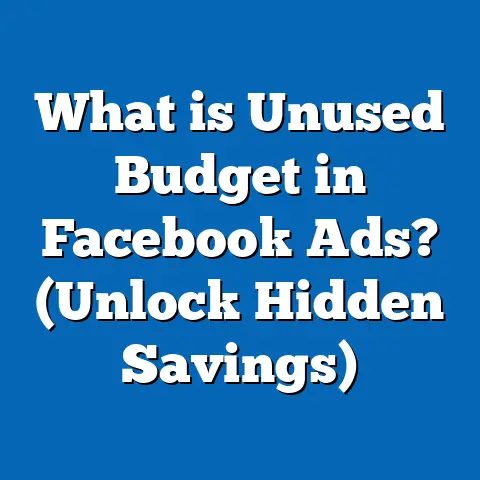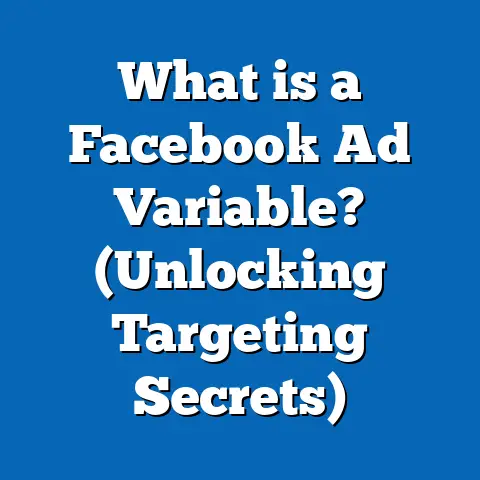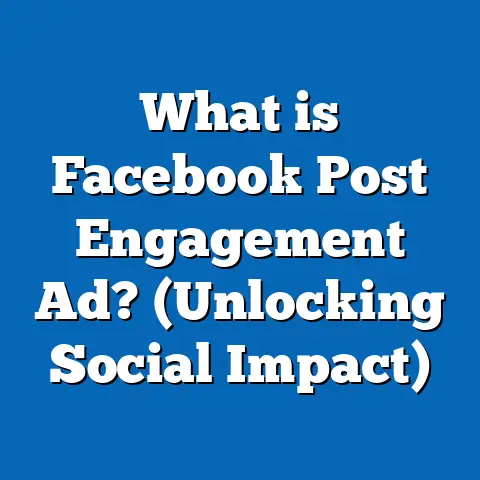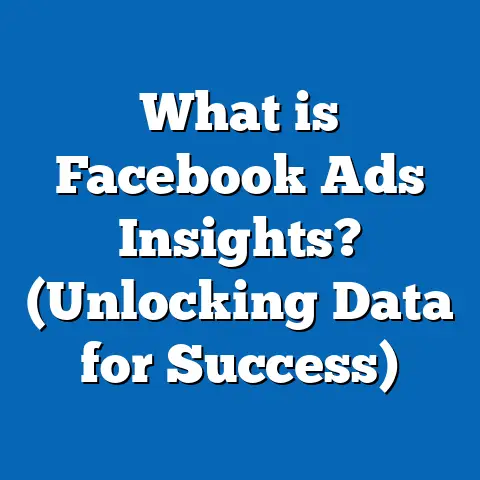What is a Campaign in Facebook Ads? (Unlocking Success Strategies)
Warning: Ignoring Facebook Ads Campaign Basics Could Cost You Thousands
Facebook advertising is a powerful tool for businesses worldwide, but without a solid understanding of the campaign structure, you risk wasting your marketing budget. Many marketers jump directly into creating ads without grasping the importance of campaigns—the foundational layer of Facebook Ads that guides every decision from targeting to budgeting. Failure to understand campaigns means your ads might never reach the right people, or worse, you’ll overspend without meaningful results.
What is a Campaign in Facebook Ads?
Understanding the Campaign Structure
A Facebook Ads campaign is the highest organizational level within the Facebook Business Manager advertising interface. It acts as a container for your ad sets and individual ads. The campaign’s primary role is to define your marketing objective—the goal you want to achieve with your advertising efforts.
Facebook structures advertising into three hierarchical levels:
- Campaign: The top-level container where you select your objective (e.g., conversions, traffic, brand awareness).
- Ad Set: This level controls targeting, budget allocation, schedule, placements (where your ads appear), and bidding strategy.
- Ads: The creative assets themselves including images, videos, headlines, and copy that users will see.
This hierarchy ensures that your advertising strategy is cohesive and organized from objectives down to the individual ad creatives.
The Role of Campaign Objectives
Choosing the right campaign objective is critical because it tells Facebook’s algorithm what you want users to do. This influences how Facebook delivers your ads — optimizing delivery for the action most important to your business.
Available objectives fall into three categories:
- Awareness: Build brand awareness or increase reach.
- Consideration: Drive traffic, engagement, app installs, video views, lead generation.
- Conversion: Encourage purchases, store visits, or other valuable actions.
Your campaign objective sets the foundation for success or failure. Opting for “traffic” when you want sales will likely result in clicks but few conversions.
Why Are Facebook Campaigns So Important?
Data-Backed Importance of Campaigns
Research by Facebook indicates that advertisers who align their campaign objectives with business goals see an average improvement of 30% in conversion rates compared to those who don’t. This is due to Facebook’s machine learning algorithms optimizing ad delivery for your defined goal.
A report from AdEspresso highlights:
- Campaigns optimized for conversions have a 20% lower cost per action (CPA) than those optimized for clicks.
- Lead generation campaigns optimized correctly show a 15% higher lead quality score.
- Brand awareness campaigns can deliver impressions to 60% more people likely to remember your brand.
These statistics underscore that campaigns aren’t just containers—they are strategic frameworks guiding Facebook’s optimization engine.
Real-World Case Study: Apparel Brand Campaign Success
An online apparel retailer ran two campaigns targeting similar audiences over 30 days:
| Metric | Traffic Objective Campaign | Conversion Objective Campaign |
|---|---|---|
| Website Visitors | 50,000 | 40,000 |
| Purchases | 500 | 1,200 |
| Cost Per Purchase (CPA) | $15 | $7 |
| Return on Ad Spend | 2.1x | 4.5x |
Despite fewer visitors, the conversion campaign generated more than twice as many purchases at less than half the cost per purchase. This illustrates how the right campaign objective drives better performance and ROI.
How to Choose the Right Campaign Objective: A Detailed Approach
Selecting the correct campaign objective requires understanding your business goals and aligning them with Facebook’s options.
Step 1: Define Your Business Goal
Ask yourself:
- Do I want to increase brand awareness among new audiences?
- Am I seeking more website traffic or app installs?
- Is my priority generating leads or driving sales/conversions?
Step 2: Understand Facebook’s Objective Categories
- Awareness
- Brand Awareness
- Reach
- Consideration
- Traffic
- Engagement
- App Installs
- Video Views
- Lead Generation
- Messages
- Conversion
- Conversions
- Catalog Sales
- Store Traffic
Step 3: Match Your Funnel Stage to the Objective
Your sales funnel stage guides objective selection:
| Funnel Stage | Recommended Objectives |
|---|---|
| Top of Funnel (Awareness) | Brand Awareness, Reach |
| Middle Funnel (Consideration) | Traffic, Engagement, Video Views |
| Bottom Funnel (Conversion) | Conversions, Catalog Sales |
Step 4: Test and Refine
Run multiple campaigns with different objectives on small budgets initially to identify what works best for your audience and product.
Deep Dive: Campaign Budget Optimization (CBO)
What is CBO?
Campaign Budget Optimization allows you to set one budget at the campaign level instead of individual ad set levels. Facebook’s algorithm then automatically distributes budget across ad sets based on performance signals.
Why Use CBO?
- Efficiency: Budget flows toward high-performing ad sets.
- Simplicity: Less manual budget management needed.
- Scalability: Easier to scale campaigns with multiple ad sets.
Data on CBO Impact
Facebook reports advertisers using CBO see an average 22% improvement in cost efficiency. However, CBO thrives when you have diverse ad sets targeting different segments or placements.
Best Practices for CBO
- Use at least 3-5 ad sets with distinct audiences.
- Ensure each ad set has multiple creatives.
- Monitor performance regularly and adjust targeting if needed.
The Anatomy of a Facebook Campaign: Key Components Explained
Target Audience Setup at Campaign Level
While audience targeting primarily happens at the ad set level, understanding how your campaign objective influences which audience Facebook targets is crucial. For example:
- Conversion campaigns target users most likely to convert based on past behavior.
- Awareness campaigns prioritize maximizing reach across broad demographics.
Placements and Their Role in Campaign Success
Facebook offers automatic placements (Facebook Feed, Instagram Stories, Audience Network) or manual placement selection at the ad set level. The campaign objective affects which placements perform best.
For example:
- Video views campaigns may perform better on Instagram Stories due to higher engagement.
- Conversions campaigns often see better ROI in Facebook Feed placements.
Common Facebook Campaign Types and Their Use Cases
Brand Awareness Campaigns
Used by companies starting out or launching new products.
Example: A beverage company launching a new flavor runs a brand awareness campaign targeting ages 18–35 interested in health drinks.
Key Metrics: Reach, Ad Recall Lift.
Traffic Campaigns
Drive users to websites or apps; good for content marketing or product discovery.
Example: A blog promoting new articles uses traffic campaigns optimized for link clicks.
Key Metrics: Click-through rate (CTR), Cost per click (CPC).
Engagement Campaigns
Increase likes, comments, shares on posts or page follows.
Example: A local restaurant announces new menu items and wants social proof via engagement boosts.
Key Metrics: Post engagement rate, Cost per engagement (CPE).
Lead Generation Campaigns
Collect user information through forms within Facebook.
Example: A real estate company collects potential buyer contacts using lead gen campaigns with pre-filled forms.
Key Metrics: Leads generated, Cost per lead (CPL).
Conversion Campaigns
Optimized for sales or specific actions on websites/apps.
Example: An online retailer drives purchases through conversion campaigns optimized using Pixel data.
Key Metrics: Cost per purchase (CPA), Return on ad spend (ROAS).
Advanced Campaign Strategies for Maximizing ROI
Dynamic Creative Optimization within Campaigns
Facebook allows dynamic creative ads where multiple headlines, descriptions, images, and calls-to-action are automatically tested across audiences within one campaign. This helps identify winning combinations efficiently.
Using Lookalike Audiences in Campaigns
Lookalike audiences mimic characteristics of your best customers and can be targeted at the campaign level via ad sets. Using lookalikes often improves conversions by reaching high-potential customers.
In-Depth Case Studies: How Businesses Successfully Use Facebook Campaigns
Case Study 1: SaaS Company Boosting Trial Signups
A software-as-a-service company used conversion campaigns targeting website visitors with lead forms optimized for free trial signups. By setting up:
- Custom audience retargeting
- High-quality video creatives explaining product features
- CBO enabled across multiple testing ad sets
They achieved:
- 40% increase in trial signups in 3 months
- CPA reduced from $25 to $12
- ROAS over 5x on paid subscriptions
Case Study 2: Local Retailer Driving Foot Traffic
A local fitness store used store traffic campaigns targeting customers within a 10-mile radius with exclusive offer ads featuring limited-time discounts. Results:
- Increased store visits by 25%
- Average cost per store visit $3.50 vs industry average $6.00
- Subsequent sales uplift of 15%
Comparing Facebook Campaigns with Other Major Platforms
| Aspect | Facebook Ads | Google Ads | LinkedIn Ads |
|---|---|---|---|
| Targeting Focus | Interest-based + demographic + behaviors | Intent via keywords | Professional data (job title/company) |
| Optimization Algorithms | Advanced ML for conversions | Keyword & auction-based optimization | Audience-based bidding |
| Ad Formats | Image, video, carousel, collection | Search ads, display banners | Sponsored content, InMail |
| Budget Flexibility | High (CBO & manual options) | High | Moderate |
Facebook’s strength lies in deep audience insights and visually rich ad formats ideal for B2C marketers.
Technical Concepts Simplified: How Facebook Algorithms Work at Campaign Level
Facebook uses machine learning models that interpret signals like user behavior and past conversion data to decide which users see your ads within a campaign objective framework. For instance:
- Conversion campaigns feed algorithms purchase events tracked by the Facebook Pixel.
- Awareness campaigns focus on maximizing impressions among people most likely to recall ads later.
The better your event tracking setup (Pixel or SDK), the more accurately Facebook can optimize delivery at the campaign level.
How to Structure Multiple Campaigns for Holistic Marketing Efforts
Often businesses run several campaigns simultaneously addressing different funnel stages:
- Awareness campaign: Broad targeting for new users.
- Engagement campaign: Boost interaction with existing followers.
- Traffic campaign: Drive visits to blog or product pages.
- Conversion campaign: Retarget warm audiences for sales.
This multi-campaign approach ensures consistent messaging tailored at every customer journey stage.
Practical Steps to Set Up Your First Facebook Ads Campaign
- Sign in to Facebook Business Manager.
- Click “Create” and select “Campaign.”
- Choose your marketing objective based on your goal.
- Name your campaign clearly reflecting its purpose.
- Decide if you want to enable CBO.
- Proceed to set up ad sets with targeting details—location, demographics, interests.
- Define budget and schedule.
- Create multiple ads with varied creatives.
- Launch and monitor daily using Ads Manager.
- Optimize by pausing underperforming ads/ad sets after sufficient data accrual (at least 3 days).
Latest Trends & Innovations in Facebook Ads Campaign Management (2024)
- Video Dominance: Video ads now generate up to 120% more engagement than images.
- AI Content Tools: Automated creative suggestions integrated within Ads Manager improve efficiency.
- Privacy Changes: Post-iOS14+ updates demand focus on first-party data collection and consent management.
- Shoppable Ads & Shops Integration: Growing e-commerce capabilities allow direct purchases from ads and Facebook Shops.
- Augmented Reality Ads: Emerging AR ad formats enhance user interaction directly within feeds or stories.
Top Tools & Resources for Managing Facebook Ad Campaigns Effectively
- Facebook Ads Manager: Core tool for campaign creation and analytics.
- Facebook Business Suite: Manage both organic posts and paid ads centrally.
- Creative Hub: Design and preview creative ideas before launching.
- Third-party tools: AdEspresso for split testing; Hootsuite Ads for scheduling; Revealbot for automation.
- Facebook Blueprint Courses: Free training modules covering all aspects of ads setup and optimization.
Common Issues & Troubleshooting Tips in Campaign Management
| Problem | Cause | Solution |
|---|---|---|
| Low impressions | Audience too narrow; low budget | Broaden targeting; increase budget |
| High CPA | Wrong objective; poor creative | Reassess objective; test new creative |
| Ad disapproval | Policy violation | Review ad policies; edit content accordingly |
| Poor conversion tracking | Incorrect Pixel setup | Verify Pixel implementation; test events |
Summary: Unlocking Success with Facebook Ads Campaigns
Mastering Facebook Ads campaigns requires understanding their hierarchical structure and strategic function in driving business goals. By choosing the appropriate campaign objective aligned with your marketing funnel stage and using features like CBO intelligently, you can significantly improve efficiency and ROI.
Continuous testing of creatives and audiences combined with leveraging advanced tools ensures you stay ahead of competitors in this fast-evolving landscape. Always track performance closely and iterate based on data-driven insights.
Final Takeaways & Next Steps
- Start with clear goals: Define what success looks like before launching any campaign.
- Choose objectives carefully: Align campaign objective with desired outcome.
- Use CBO when applicable: Let Facebook optimize budget distribution across ad sets.
- Test creatives & audiences regularly: Avoid stagnation by continuous experimentation.
- Monitor & scale strategically: Increase budgets gradually based on performance data.
- Stay updated: Follow latest features and privacy changes regularly.
- Leverage case studies & benchmarks: Learn from proven strategies in your industry.
By mastering these elements of Facebook Ads campaigns, marketers can unlock significant growth opportunities while minimizing wasted spend.
If you want me to expand specific sections further or add more case studies/data points or examples from other industries (B2B, local services), please let me know!

